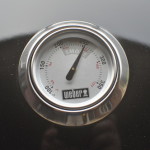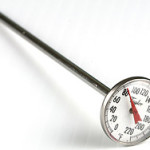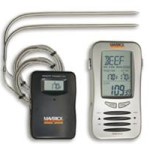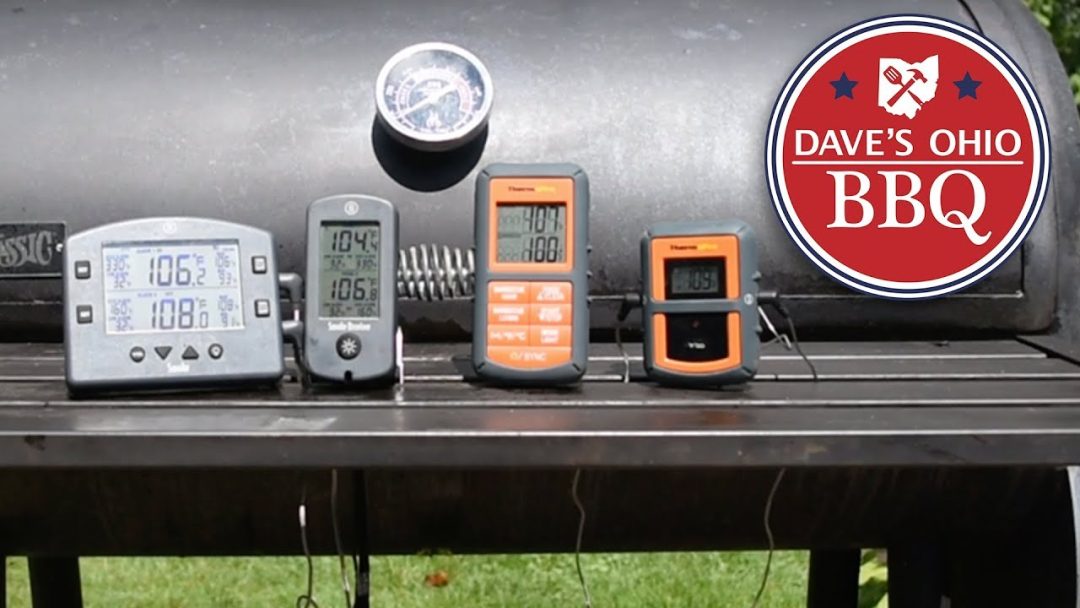BBQ thermometers come in a variety of styles and vary considerably in price. With this post, I hope to give you some guidelines in choosing the best BBQ thermometer for your particular needs.
First, let us break the ice a little bit by introducing some quotes by folks that should know a bit about grill and meat BBQ thermometers.
“Cooking without good digital thermometers is like driving at night without headlights. Dial thermometers are technology from the 1800s and they are often waaaay off.” Meathead Goldwyn @ AmazingRibs.com
“Bi-metal coil thermometers are about as accurate as a sniper scope on a nerf gun.” Alton Brown, Food Network Star, author of multiple cookbooks
I think you can see where these two experts stand on their preference for cooking thermometers.
Bi-metal Dial BBQ Thermometer
Bi-metal technology has been used in thermometers for more than two centuries. This is the style of thermometer you will see most often in the domes of both charcoal and gas grills.
 These thermometers use old school coil spring technology. The sensing device is made up of two different metals fastened together. Of the two metals, one has low heat sensitivity, while the other metal has high heat sensitivity. With changing temperatures the metals expand or contract at different rates causing the metal strip to curl. Since the bi-metal sensor is attached to the needle on the face of the thermometer, the changing temperature results in a curling of the metal strip moving the needle on a printed temperature scale.
These thermometers use old school coil spring technology. The sensing device is made up of two different metals fastened together. Of the two metals, one has low heat sensitivity, while the other metal has high heat sensitivity. With changing temperatures the metals expand or contract at different rates causing the metal strip to curl. Since the bi-metal sensor is attached to the needle on the face of the thermometer, the changing temperature results in a curling of the metal strip moving the needle on a printed temperature scale.
You will want to ensure the accuracy of your dial thermometer is within your desired range. Because of the dual metal combination, these thermometers tend to be more accurate at higher temperatures than they are at lower temperatures. Consequently, since you will be using these while cooking presumably at higher temperatures you will want to calibrate for accuracy at the higher end of the spectrum.
The most common way to calibrate your thermometer is to place the sensor in either freezing water at 32 degrees Fahrenheit or in boiling water. If you are calibrating at the boiling point you will need to know what the boiling point of water is at your elevation since these changes at different altitudes.
The boiling point of water is 212 degrees Fahrenheit at sea level. The boiling point decreases by 1/2 degree for approximately each 250 feet rise in elevation. This means that at 1,000 feet above sea level the boiling point of water will be approximately 210 degrees Fahrenheit.
If you calibrate your dial thermometer at freezing, which is impacted very little by barometric pressure change, you may find that it is not accurate at your normal cooking temperatures. Always calibrate at the end of the temperature scale closest to your normal use.
Bi-metal Instant Read BBQ Thermometer
You will typically see this type of thermometer as the common pocket thermometer. It has a 2″ or 3″ metal probe with a dial thermometer reading at one end. While these may be billed as “instant-read” they may be far from that when compared to a digital thermometer with a thermocouple tip.
 The bi-metal instant-read thermometer will typically have a response time of 13 to 20 seconds. This does not sound like a long time but when compared to some of the better digital thermometers it about 6 times as long. 20 seconds compared to 3 seconds for the digital can seem like an eternity, especially if you are trying to maintain an even temperature on your grill.
The bi-metal instant-read thermometer will typically have a response time of 13 to 20 seconds. This does not sound like a long time but when compared to some of the better digital thermometers it about 6 times as long. 20 seconds compared to 3 seconds for the digital can seem like an eternity, especially if you are trying to maintain an even temperature on your grill.
Digital Instant Read Thermometer
If you are looking for temperature accuracy in your outdoor cooking, and you should be, you will want to turn your attention to the digital instant-read food thermometers on the market today. As you commence searching for that one heat gauge that fits your needs you will find a wide variety of prices and almost as wide a variety of brands. Sorting through those can be a challenge.
Your grill will have hot spots throughout the cooking surface. In addition, your meat may be of different thicknesses. Your turkey leg may be cooking at a different rate than the breast. It is imperative to know that the meat you are serving is at the correct temperature to avoid any foodborne illnesses.
Here is what Harry Soo of Slap Yo Daddy BBQ has to say about the Thermapen digital meat thermometer.
Whether you’re a low-and-slow barbecue pitmaster or backyard griller, you know you need a good BBQ thermometer. The $100 Thermapen manufactured in England is the de facto standard for BBQ pitmasters because it’s the Lamborghini of instant read thermometers.
Obviously this is not your run of the mill digital temperature gauge, but it does satisfy the needs of the discriminating chef and backyard cook.
If you are not quite ready to fork over the approximately $100 for the Thermapen, Thermoworks did start offering the Thermopop in 2013. This thermometer will not give you your food temperature in less than 3 seconds like the Thermapen it will give you an accurate response in less than 6 seconds.
Oven/Grill/Smoker Thermometer or Digital Probe
While the rapid read thermometers are great for checking the meat temperature, they are too thin and fragile to survive being in the cooking chamber for any length of time. This is where a digital probe or cooking chamber thermometer comes into play.

These units will have a thicker probe built to withstand the heat and will be attached to a cable in order to read the temperature outside the cooker or oven. This allows you to maintain a more even and consistent cooking temperature.
While some units are basic other units will have all kinds of extra features. Some units will come with at least two probes where you can keep tabs on the temperature at the grill grate as well as having one probe inserted into the meat to keep up to date with the internal temperature of the meat.
Ensuring that your food is cooked fully by using a barbecue thermometer
Cooking barbecue food is relatively easy, but do you know when your food is properly cooked to a hygienic standard? The only way to know for certain is by using a good quality barbecue thermometer and understanding the different temperatures at which different meats are considered fully cooked. We will show you what to look out for and why you should always use a good quality BBQ thermometer when cooking your barbecue food.
- There are 3 important temperatures with which every barbecue cook should be familiar with:
- External Temperature – determines if your food is going to cook quickly or not depending on what the temperature is outside.
- Grill Temperature – what the temperature is in the cooking chamber of your grill. This will help you determine how long it will take the meat to cook. For example, at 350 degrees, the meat will cook at approximately twenty minutes per pound. So, a ten-pound chicken will take approximately 3:33 hours to completely cook at 350.
- Internal Meat Temperature – this is your “target” temperature. It tells you if your meat has come up to the proper temperature and is ready to consume.
- You should remember that many meat thermometers do not provide an accurate reading. To find out if your BBQ thermometer is accurate or not, simply place a pan of cold water on your cooker, and bring the water to a rolling boil at 212 degrees. Place the stem of the thermometer into the pan of water for 60 seconds. If it is properly adjusted, the barbecue thermometer should read 212.
- You should only buy a thermometer that comes with a nut on the rear of the dial case. This allows you to optimize the dial indicator by using some pliers to correct the setting.
- Temperature forks do not perform very well. In preference, you should always opt to use an accurate instant display meat thermometer and use it every time you have a barbecue.
- Instant display and handheld thermometers should be left in the food for around 60 seconds to get an accurate reading and should not be left attached for the whole duration of cooking.
In Summary
At a minimum, the outdoor cook/chef should have at least three different types of thermometers.
- An instant-read or quick-read thermometer to get the internal temperature of meat on the grill
- A digital probe thermometer for monitoring the cooking temperature of the cooking chamber while smoking or roasting thicker cuts of meat
- A digital probe to insert into the thick cut of meat being roasted or smoked in order to keep an eye on the internal temperature
With a good digital thermometer and diligence and care in your outdoor barbecuing, you will have one fantastic meal to present to your guests.
